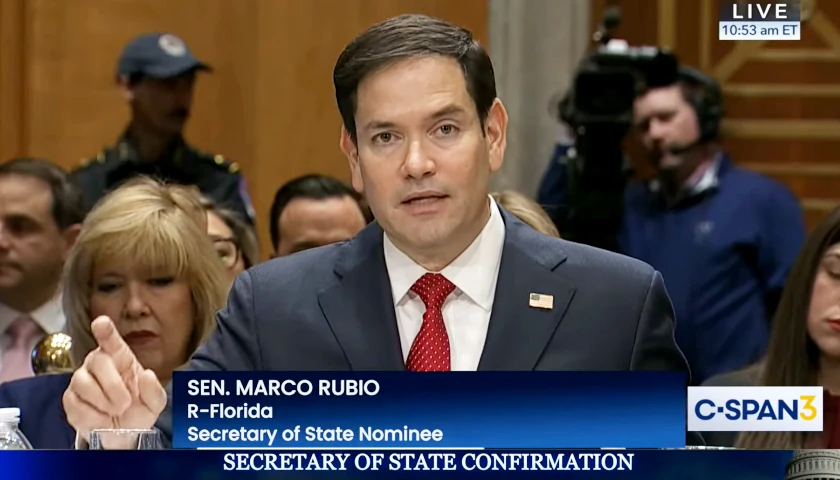by Kevin Killough
Ahead of the Easter weekend, multiple media outlets reported that chocolate prices are soaring, and according to the coverage, the main culprit driving the inflating costs is climate change.
Across multiple platforms, the reports followed a similar message, using similar language to describe the problem and its causes — and the reports all came out the same week.
“Easter egg prices soar as cocoa crops are hit by climate crisis and exploitation,” the Guardian reported on Good Friday. The article blames the shortage of cocoa, which is used to make chocolate, on rising prices of fertilizers, deforestation, illegal mining practices and “extreme weather events.”
The article doesn’t provide any details on these alleged events, but it does mention El Niño, which is a warming of the ocean surface in the central and eastern tropical Pacific Ocean. It causes changes in weather patterns during the cycle. This cycle was recorded long before carbon dioxide emissions were a factor in the atmosphere.
An National Public Radio segment, which also ran on Good Friday, interviewed its business correspondent, who said “farmers there [in the Ivory Coast and Ghana] have been facing extreme weather, changing climate patterns, which have just decimated crop harvests.” NPR provided no data or sourcing for the environmental claims.
Writing in The Conversation, reporter Jack Marley’s headline suggests that climate change “may” be the culprit, and he then goes on to write that “food production globally is facing an increasingly hostile climate.”
While African cocoa farmers in 2023 may have had a bad year, crop data doesn’t show any downward trends in African yields. Between 2007 and 2022, cocoa yields actually went up. This is true for many crops in many regions across the world, including rice, soybeans, wheat and corn. This data is easy to find, but not a single article on rising chocolate prices in any of these media outlets mentioned this mitigating data.
Marley didn’t respond to questions if he was aware of this data or if he ever sought it out.
Shaping a uniform narrative
The Guardian, NPR and The Conversation are among the hundreds of media outlets associated with or listed as partners with an organization called Covering Climate Now (CCN), which encourages reporters to insert “climate crisis” narratives into all their stories.
Covering Climate Now boasts partnerships with hundreds of major media outlets across the world. According to CCN, its partners have a combined audience of 2 billion people – one-fourth of the globe’s population — in 57 countries.
The group provides advice to reporters on all beats to not only insert a “climate crisis” narrative into every beat, but also how to cover the topic. This includes telling journalists not to platform what it calls “denialists,” which includes anyone who “ridicules” climate activists or suggests that climate change is not producing a global emergency.
The site is full of tips on what language to use, how to write headlines and suggested stories for journalists to cover, all in line with an anti-fossil message. It suggests avoiding “fake experts.” To determine the value of experts a reporter might interview, CCN points them to the activist website DeSmog, which demonizes anyone, even those on the left, who in any way dispute the “climate crisis” narrative.
The Covering Climate Now section on solutions to what it says is an indisputable crisis leaves no room for fossil fuel use, even though experts say that rapidly eliminating them is not only unrealistic, it would necessitate the collapse of civilization.
“Hitting that 2050 target will require rapidly phasing out oil, gas, and coal burning; reversing deforestation; shifting from the current industrial model of agriculture to climate-friendly farming methods; and much more,” the CCN section states.
The organization encourages reporters to make statements attributing “extreme weather” to climate change, even in the absence of any data to support the claims.
“Even in the absence of explicit attribution data, it’s accurate to say that climate change is making extreme weather more common and more severe,” CCN tells its partnered media organizations. It then provides tips for language journalists can use to blame “extreme weather” on climate change for any story.
Contrary to CCN’s advice, attributing extreme weather to climate change in many instances goes against what the research shows. The Intergovernmental Panel on Climate Change (IPCC), a United Nations consortium of the world’s leading climate scientists, finds little in the way of trends regarding floods, droughts, hurricanes and tornadoes, much less a signal that could attribute trends to human-caused climate change.
As Dr. Roger Pielke, Jr., professor of environmental studies at the University of Colorado at Boulder, explains in a series of articles on various types of natural disasters, the IPCC’s research on this topic is full of uncertainties.
Covering Climate Now doesn’t mention any of this research and instead tells reporters, “Human-caused climate change isn’t solely to blame for extreme weather, but it supercharges normal weather patterns, like steroids.”
Blurred lines
Covering Climate Now didn’t respond to questions from Just The News about these misleading statements, but media experts have raised concerns about the bias that CCN is encouraging.
“They say that it’s about improving climate coverage. What they really mean is having climate coverage that appeals to exactly what they want said,” Jon Pepper, a communications consultant and novelist, told Just The News.
Writing in “Issues In Science and Technology,” a quarterly science journal, in 2019, Matthew Nisbet, of American University’s School of Communication, discussed how Covering Climate Now places too much certainty on the connection between extreme weather and climate change and veers from the world of traditional objective journalism into advocacy.
Nisbet, who like Pielke supports an energy transition to address climate change, argues that such an approach will undermine trust in the media and effective solutions to the problem.
“The new Covering Climate Now initiative must strongly challenge longstanding biases in environmental reporting, rather than reinforcing them. The project is shaping up to become an echo chamber for climate change activism, just another symptom of today’s bitter political culture,” Nisbit wrote.
Covering Climate Now charges nothing for membership. It’s supported by anti-fossil fuel groups such as the Park Foundation, the Waverly Street Foundation, and Actions@EBMF. The group previously received funding from the Rockefeller Foundation, which had $5.2 billion in net assets in 2022, according to its tax filings, and funds many media organizations directly to advance the organization’s anti-fossil fuel message.
The Rockefeller Foundation was one of the anti-fossil fuel organizations that provided the Associated Press with a three-year grant totaling $8 million specifically to support the service’s coverage of climate change. The Associated Press was also among the outlets last week blaming climate change for the rise in chocolate prices. The Rockefeller Foundation also provided funding to The Guardian and NPR for their climate coverage.
The effort to weave the “climate crisis” narrative into all media people consume goes beyond the news. It also includes entertainment.
Good Energy Stories provides “consulting services” on how to insert political messages regarding climate change into television, film, and media.
It’s not clear how many projects the group has been involved in. Its founder, Anna Jane Joyner, told The New York Times that nondisclosure agreements prevent her from saying which books, movies, or TV shows it has influenced, but it provides a playbook on how to fit climate change into non-news stories.
Like Covering Climate Now, the organization’s funders are anti-fossil fuel nonprofits, such as the Sierra Club and Bloomberg Philanthropies, the latter of which provided $1 billion to efforts to ban gas stoves and shut down all coal plants worldwide.
Good Energy stories didn’t respond to requests for comment on this article.
Cli-fi
Pepper, the communications consultant and novelist, wrote a series of books called the “Fossil Feuds,” which center on the wealthy Crowe family and their New York-based energy empire as they struggle to adapt to modern times. The latest in the series, “Missy’s Twitch,” is about the Crowe family heiress who develops overwhelming anxiety to what she believes is a looming “climate apocalypse.”
Pepper said he wrote the series as a counter to “Cli-fi,” a genre of science fiction that portrays dystopian futures in which humanity struggles to survive in a world completely destroyed by climate change, something the IPCC does not present as a possible outcome of climate change under any scenario, even one in which no policies are adopted to address carbon dioxide emissions.
“The catastrophe is really the solutions they’re imposing on us. That is the potential disaster far more than anything that comes from climate change,” Pepper said.
Pepper said some of the climate activists’ ideas that are saturating the media through groups like Good Energy Stories and Covering Climate Now are dangerous. They’re expensive and create energy scarcity, which is effectively policy-induced poverty. “They’d like to have the cloak of virtue around them, but to me, I think some of this stretches morality in very unfortunate ways,” Pepper said.
O.H. Skinner, executive director of Alliance for Consumers, said in an interview that Covering Climate Now and Good Energy Stories are part of a playbook of the political left. They have a vision of what lifestyle choices they want people to make, and the “climate crisis” narrative, he said, gives them a means to push policies that enforce it.
“It’s not enough for them, for people to just buy a more fuel-efficient car. They need them to basically stop having cars, or certainly stop having gas-powered cars. That’s where they want the world to go. And so if you want to ban two-thirds of the cars on the road, you better have a consistent narrative in the media. Or else people are going to rightly be very unhappy with that reality, which we’re starting to see,” Skinner said.
Skinner said 20 years ago, the left’s strategy was to put energy star stickers on consumer goods.
“That didn’t work, apparently, because now they’re resorting to mandates and bans and wiping things off the market,” Skinner said.
Dr. Matt Wielicki, former assistant professor in the Department of Geological Sciences at the University of Alabama and author of “Irrational Fear,” told Just The News that groups like Good Energy Stories and Covering Climate Now are trying to purge any notion of nuance and uncertainty in climate science because that undermines the overarching goal.
That goal was originally a transition in the energy system to wind and solar, he said, but as the that goal encounters more and more problems, the discussion is now shifting to “degrowth” and strategies that are basically a redistribution of wealth.
“They definitely want to ignore any honesty about the scientific complications that exist in the climate system, because it clouds this nice, pretty narrative that everything is because of fossil fuels and CO2. They just want to radically change the system of capitalism,” Wielicki said.
Skinner said the policies the left is “fixated” on all drive up the costs of everything and channel people into the lifestyle choices that the climate activists want people to make.
“When you drive up the price of a person’s car, you drive up their electricity bill, you make it really expensive to do things. It’s anti-consumer,” he said.
Thirsty for good news
Wielicki said media are becoming so saturated with the “climate crisis” narrative that it’s beginning to have the opposite effect. It’s producing more skepticism, he said, and there’s a growing audience that is thirsty for a more reasonable message. It’s something he saw as a professor when he challenged alarmist narratives in his classroom.
“They were thirsty for that knowledge. They were fed up and mentally exhausted with being bombarded by catastrophe after catastrophe. They are really thirsty for some good news,”
Skinner said the “climate crisis” narrative is beginning to run into problems as the regulatory solutions become costly for consumers. Wind and solar are driving up electricity prices, electric vehicle mandates are making cars more expensive, and efficiency standards are raising the costs of appliances.
Polls that ask people if they’re concerned about climate change find a large portion of the public is. But polls that ask how concerned they are in relation to other problems, how much they’re willing to spend to address the problem and what lifestyle changes they’re willing to make find far less support for the solutions that CCN pushes reporters to focus on.
As these costs are imposed upon people more and more to fight climate change, Skinner said, skepticism will increase. “You’re really starting to see some of this stuff become real for everyday people. And it’s not super popular,” he said.
Pepper said that the “climate crisis” narrative has become so pervasive that it will be hard to dislodge. Besides the efforts of CCN to insert that message across all news reports and Good Energy Stories putting it in entertainment media, Pepper said, the education system starts drilling it into students’ heads from a young age.
“There’s a lot to overcome in terms of raising some skepticism about this and really working to find out what is the truth. What can we control? What are we not able to control? And what’s the sensible policy going forward at the global level, at the local level and so on?” Pepper said.
– – –
Kevin Killough is a reporter for Just the News.





